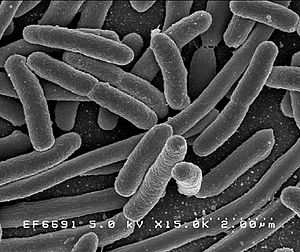Gut flora facts for kids

Gut flora consists of microorganisms that live in the digestive system of animals. It is the largest reservoir of microbes in the human microbiome.
The human body, consisting of about 100 trillion cells, carries about ten times as many microorganisms in the intestines. The metabolic activities performed by these bacteria resemble those of an organ, leading some to call gut flora a 'forgotten organ'. It is estimated that these gut flora have around 100 times as many genes in aggregate as there are in the human genome.
Bacteria make up most of the flora in the colon and up to 60% of the dry mass of faeces. Somewhere between 300 and 1000 different species live in the gut, with most estimates at about 500. However, it is probable that 99% of the bacteria come from about 30 or 40 species. Fungi and protozoa also make up a part of the gut flora, but little is known about their activities.
Research suggests that the relationship between gut flora and humans is not merely commensal (a non-harmful coexistence), but rather a symbiotic relationship. Though people can survive without gut flora, the microorganisms perform a host of useful functions, such as fermenting unused energy substrates, training the immune system, preventing growth of harmful, pathogenic bacteria, regulating the development of the gut, producing vitamins for the host (such as biotin and vitamin K), and producing hormones to direct the host to store fats. However, in some conditions, some species can cause disease by producing an infection or increasing cancer risk for the host.
Such food compounds as polyphenols, oligosaccharides and polysaccharides may be useful for good bacteria and help reduce pathogenic species of human gut flora.
Over 99% of the bacteria in the gut are anaerobic, but in the cecum, aerobic bacteria reach high densities.
The traditional view is that no metazoan phylum can break down cellulose by producing the enzyme cellulase. Instead, herbivores contain, in their gut, microorganisms which produce cellulase. This is important because cellulose is the most common organic compound on Earth. About 33% of all plant matter is cellulose (the cellulose content of cotton is 90% and that of wood is 40–50%). Recently, evidence has emerged that some animals do produce their own cellulase. The question is not yet quite settled.
Related pages
Images for kids
-
Candida albicans, a dimorphic fungus that grows as a yeast in the gut
See also
 In Spanish: Microbiota intestinal para niños
In Spanish: Microbiota intestinal para niños



